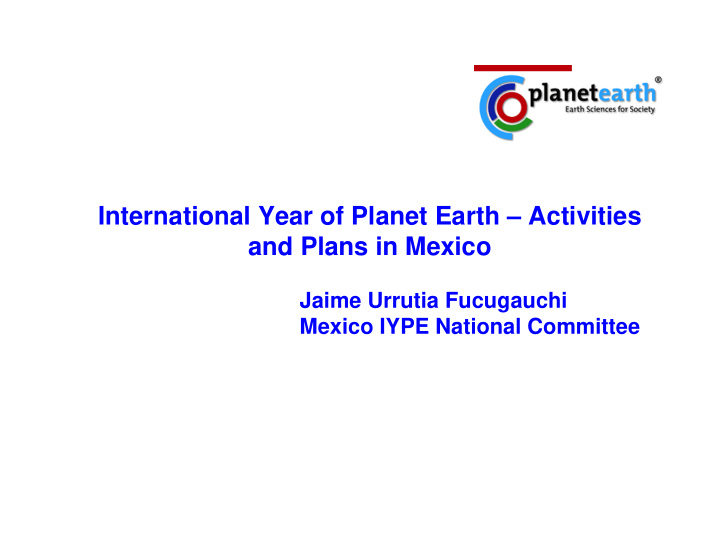



International Year of Planet Earth – Activities and Plans in Mexico Jaime Urrutia Fucugauchi Mexico IYPE National Committee
Summary The International Year of Planet Earth (IYPE) started as a joint initiative by UNESCO and IUGS with the participation of several geosciences organizations, and has developed into a major program in geosciences with the inclusion and participation of national committees. In this presentation we focus on current activities and plans in our country, and participation in the international activities. The Mexican community has been a part of the international programs starting with the International Geophysical Year in 1957-1958 and continuing through its participation in the Upper Mantle, Geodynamics and Lithosphere Projects. IYPE activities this year have concentrated in publications and organization of conferences and meetings. A book series on Earth Science Experiments for Children has been defined, with the first books published on “Atmospheric Pressure and Free Fall of Objects” and “Light and Colors”. Following books are on “Standing on Archimedes” and “Foucault and the Climate”. Books are distributed to school children, with more than 10,000 copies given free of first volumes. Other publications include the special issues of El Faro science magazine edited by the National University, with last issue published and distributed electronically and in hard copies this August. Special events include the Conference of IYPE Executive Director on the IYPE initiative presented during the International Day of Science Museums in late May in the Science Museum Universum. This was followed by a Planet Earth Week in the University. In late May we had the AGU Joint Assembly, with strong international participation from US, Canada, Europe, Latin America and elsewhere.
Activities in 2008 Plans for 2008 include an inaugural event in Mexico City and at other localities in the country (Morelia, Queretaro, San Luis Potosi, Ensenada, Merida, and Pachuca), and participation in the international activities in particular at the launching IYPE event in Paris, France. Current plans include an electronic e-newsletter in Spanish and English and an open-access outreach publication, additional publications of the Planet Earth Chlidren Book Series, articles and special issues in journals and magazines in the science and outreach programs, and events on selected themes from the IYPE science program, particularly on Megacities, Hazards, Mineral and Energy Resources and Life (Biodiversity in Mexico). In 2008, special events are planned on the Megacities program. The metropolitan area of Mexico City, with around 20-24 million inhabitants presents special challenges, being at high altitude within an active tectonic and volcanic area requiring major efforts in water supply, water control, rains and waste disposal and management. Involvement in international activities includes translation into Spanish of IYPE publications and the participation in programs and activities. In addition to activities in the different countries, we consider that IYPE should result in initiatives for enhancing international cooperation and to ensure increased effective use by society of Earth Sciences
The country has a long tradition in geosciences tradition that goes back to the indigenous cultures Mining was a major activity in pre-hispanic and colonial times Exploration for energy and mineral resources continue as major activities The International Year of Planet Earth initative has been well received in Mexico, partly related to the rich heritage in the geosciences, the occurrence of mineral and energy resources and the active geophysical and geological phenomena, and partly because of the need to promote education, research and outhreach activities
Active Land – Natural Hazards Earthquakes and Volcanoes
The geosciences community in Mexico is small There are relatively few Earth Science Departments for the size of the country. There are just a few geosciences research centers Few State Universities offer degrees in geophysics, geology, geological engineering, mining and related Fields. There are some four postgraduate programs offering PhD and MSc degrees Geoscience's curricula in primary and secondary schools is non existent There are about 1400 geophysicists in a country with some 120 million habitants Although more than 60 % of the Federal Government fiscal income comes from oil, gas and minerals, government officials, politicians, and citizens know little about geosciences
Meeting of National Committee with IYPE Executive Director IYPE activities started in 2005 and in 2006 Mexico joined the program Conference Universum Science Museum Mexico City May 18, 2007
Publications El Faro (January 2006)
El Faro (June 2007) Interview with IYPE Executive Director Ed de Mulder
El Faro (August 2007) Special Thematic Volume on Planet Earth
Megacities IYPE Program Metropolitan area around 20-22 million inhabitants Mexico City presents special challenges, being at high altitude within an active tectonic and volcanic area requiring major efforts in water supply, water control, rains, land use and waste disposal and management.
Science Priority Programs Natural Hazards Seismicity Active Volcanoes Hurricans Tropical Storms Floods Land slides Droughts
Science Priority Programs Deep Earth Geophysics
Planet Earth Web Site Mexico National Committee http://www.geociencias.unam.mx/geociencias/iype_cgeo/index.html
Special Activities for Children Workshop on Climate Change and Greenhouse Effects Science Museum for Children “El Papalote”
Children Book Series Simple Experiments for a Complex Earth 20,000 copies have been distributed free in Schools 2nd Edition is in progress
Books in the Planet Earth Series are available elecronically for use by other National Committees The first four books in the Planet Earth Series have been edited.
The IYPE Student Contest in Mexico
2008 Planet Earth Conference Cycles Posters and Printed Material
Year of Planet Earth in Mexico Plans include: - A Planet Earth e-Newsletter (English and Spanish), which could be used in other countries - Special volumes in peer-reviewed journals on the science programs (megacities, hazards, etc) -Calendar and Printed Material Available for Free Distribution and use by other National committees Calendars, Book Markers, …
Sponsors
Thanks!!! Thanks!!!
Recommend
More recommend